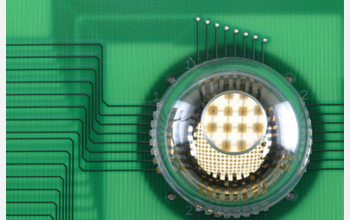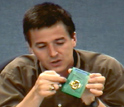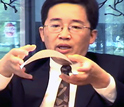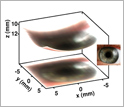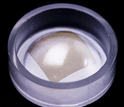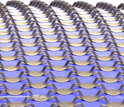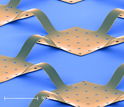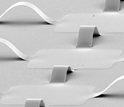News Release 08-132
The Shape of Things to Come
Flexible web of micro-sensors enables eye-shaped camera, heralds new class of electronics technology that can conform to almost any shape
August 6, 2008
View video interviews by engineers John Rogers of the University of Illinois at Urbana-Champaign and Yonggang Huang of Northwestern University.
This material is available primarily for archival purposes. Telephone numbers or other contact information may be out of date; please see current contact information at media contacts.
Instead of using a flat microchip as the light sensor for their new camera, a team of engineers has developed a sensor that is a flexible mesh of wire-connected pixels.
The mesh is made from many of the same materials as a standard digital-camera sensor, but has the unique ability to conform to convoluted, irregular surfaces.
The technology is already showing promise for photography, as the researchers conformed the array to a hemispherical shape and incorporated the device into a working eye-like camera. The new system eliminates some of the aberrations caused by current camera designs and improves the quality of captured images.
Researchers are testing the same design principles in a range of other applications, including as a thin, conformable monitor to detect electrical signals traveling across the undulating surface of the human brain.
Led by John Rogers of the University of Illinois at Urbana-Champaign and Yonggang Huang of Northwestern University in Evanston, Ill., the researchers announced their findings Aug. 7, 2008, in the journal Nature.
"This research is truly transformative," said Ken Chong, advisor in the National Science Foundation (NSF) Engineering Directorate, who is one of the officers overseeing the researchers' NSF grant. "Using simple mechanics principles, the researchers have produced, for the first time, electronic devices on a hemispherical surface so that they can take images much like those captured by the human eye."
The technology breakthrough is a novel approach that bypasses a traditional planar sensor of adjacent pixels and instead relies upon an array of pixels interconnected by small wires. Using a flexible, temporary backing, the researchers can form the array into a curved shape and then transfer the array to its permanent location affixed to a glass lens.
Over the last 20 years, many researchers have tried to manufacture such electronic eye systems, but until now, none were able to create a working camera.
"This strategy opens up exciting, new engineering design possibilities by eliminating the two dimensional, planar constraints of conventional, semiconductor wafer-based optoelectronics," said John Rogers, Flory-Founder Chair Professor of Materials Science and Engineering at University of Illinois at Urbana/Champaign.
While a flat, planar sensor cannot flex without damaging its light-sensitive pixels, the new technology puts the strain on the wires, each flexing as much as 40 percent. Since the wires absorb the strain, the pixels are barely stressed, even when affixed to the retina-shaped housing of the new experimental camera.
Conventional digital cameras use planar chips based on rigid, brittle semiconductor wafer substrates that fracture at strains of less than 1 percent.
"Mechanics helps to reduce the stresses and strain in components, and guide and optimize the system design," said Yonggang Huang, Joseph Cummings Professor of Civil and Environmental Engineering and Mechanical Engineering, Northwestern University, who worked with his team to model the mechanical properties of the design so that it could be manufactured.
The current sensor array includes only 256 pixels, but because the technology is based on established materials and manufacturing processes, the researchers ultimately expect more sophisticated sensors in higher density arrays. The same approaches can be used for nearly any class of semiconductor electronic device for a range of functions such as sensing, actuating and computing.
"We believe that some of the most compelling areas of future application involve the intimate, conformal integration of electronics with the human body, in ways that are inconceivable using established technologies," said Rogers, who is also affiliated with the Beckman Institute for Advanced Science and Technology and the Frederick Seitz Materials Research Laboratory. "We are working actively with collaborators to explore possibilities in advanced health monitors, prosthetic devices and therapeutic systems.
The electronic eye research emerged in part from the collaborative activities of the Center for Nano-Chemical-Electrical-Mechanical Manufacturing Systems (Nano-CEMMS).
-NSF-
-
View Video
John Rogers describes the new camera he helped develop that is based on the eye's structure.
Credit and Larger Version -
View Video
Yonggang Huang describes the new retina-like camera sensor and flexible photosensitive pixels.
Credit and Larger Version -
Actual image of an eye obtained with the new 256-pixel electronic eye camera.
Credit and Larger Version -
Silicon focal plane array (brown) and electronics on a hemispherical transfer element (translucent).
Credit and Larger Version -
Low magnification SEM image of interconnected Si photodetector pixels and electronics on substrate.
Credit and Larger Version -
High magnification SEM image of interconnected Si photodetector pixels and electronics on substrate.
Credit and Larger Version -
Close-up of the silicon photodetector pixels and electronics interconnected by arc-shaped ribbons.
Credit and Larger Version
Media Contacts
Joshua A. Chamot, NSF, (703) 292-7730, email: jchamot@nsf.gov
Megan Fellman, Northwestern University, (847) 491-3115, email: fellman@northwestern.edu
Kyle Delaney, Northwestern University, (847) 467-4010, email: k-delaney@northwestern.edu
James Kloeppel, University of Illinois at Urbana-Champaign, (217) 244-1073, email: kloeppel@uiuc.edu
Program Contacts
Ken P. Chong, NSF, (703) 292-7008, email: kchong@nsf.gov
Principal Investigators
John Rogers, University of Illinois at Urbana-Champaign, (217) 244-4979, email: jrogers@ad.uiuc.edu
Co-Investigators
Yonggang Huang, Northwestern University, (847) 467-3165, email: y-huang@northwestern.edu
The U.S. National Science Foundation propels the nation forward by advancing fundamental research in all fields of science and engineering. NSF supports research and people by providing facilities, instruments and funding to support their ingenuity and sustain the U.S. as a global leader in research and innovation. With a fiscal year 2023 budget of $9.5 billion, NSF funds reach all 50 states through grants to nearly 2,000 colleges, universities and institutions. Each year, NSF receives more than 40,000 competitive proposals and makes about 11,000 new awards. Those awards include support for cooperative research with industry, Arctic and Antarctic research and operations, and U.S. participation in international scientific efforts.
Connect with us online
NSF website: nsf.gov
NSF News: nsf.gov/news
For News Media: nsf.gov/news/newsroom
Statistics: nsf.gov/statistics/
Awards database: nsf.gov/awardsearch/
Follow us on social
Twitter: twitter.com/NSF
Facebook: facebook.com/US.NSF
Instagram: instagram.com/nsfgov



